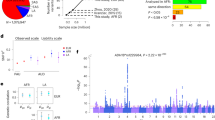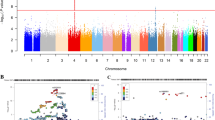Abstract
To identify sequence variants in genes that may have roles in neuronal responses to alcohol, we resequenced the 5′ region of tyrosine kinase B neurotrophin receptor gene (NTRK2) and determined linkage disequilibrium (LD) values, haplotype structure, and performed association analyses using 43 single nucleotide polymorphisms (SNPs) covering the entire NTRK2 region in a Finnish Caucasian sample of 229 alcohol-dependent subjects with antisocial personality disorder (ASPD) and 287 healthy controls. Individually, three SNPs were associated with alcohol dependence and alcohol abuse (AD) (P-value from 0.0019 to 0.0059, significance level was set at P⩽0.01 corrected for multiple testing), whereas a common 18 locus haplotype within the largest LD block of NTRK2, a 119-kb region containing the 5′ flanking region and exons 1–15, was marginally overrepresented in control subjects compared to AD individuals (global P=0.057). Taken together, these results support a role for the NTRK2 gene in addiction in a Caucasian population with AD and a subtype of ASPD.
This is a preview of subscription content, access via your institution
Access options
Subscribe to this journal
Receive 6 print issues and online access
$259.00 per year
only $43.17 per issue
Buy this article
- Purchase on Springer Link
- Instant access to full article PDF
Prices may be subject to local taxes which are calculated during checkout

Similar content being viewed by others
References
Reich T, Edenberg HJ, Goate A, Williams JT, Rice JP, Van Eerdewegh P et al. Genome-wide search for genes affecting the risk for alcohol dependence. Am J Med Genet 1998; 81: 207–215.
Li T-K, Hewitt BG, Grant BF . Alcohol use disorders and mood disorders: a National Institute on Alcohol Abuse and Alcoholism perspective. Biol Psychiatry 2004; 56: 718–720.
True WR, Xian H, Scherrer JF, Madden PAF, Bucholz KK, Heath AC et al. Common genetic vulnerability for nicotine and alcohol dependence in men. Arch Gen Psychiatry 1999; 56: 655–661.
Liu Q-R, Drgon T, Walther D, Johnson C, Poleskaya O, Hess J et al. Pooled association genome scanning: validation and use to identify addiction vulnerability loci in two samples. Proc Natl Acad Sci USA 2005; 102: 11864–11869.
Bergen A, Yang X, Bai Y, Beerman M, Goldstein A, Goldin L . Genomic regions linked to alcohol consumption in the Framingham Heart Study. BMC Genet 2003; 4: S101.
Gelernter J, Liu X, Hesselbrock V, Page GP, Goddard A, Zhang H . Results of a genomewide linkage scan: support for chromosomes 9 and 11 loci increasing risk for cigarette smoking. Am J Med Genet Part B: Neuropsychiatr Genet 2004; 128B: 94–101.
Long JC, Knowler WC, Hanson RL, Robin RW, Urbanek M, Moore E et al. Evidence for genetic linkage to alcohol dependence on chromosomes 4 and 11 from an autosome-wide scan in an American Indian population. Am J Med Genet 1998; 81: 216–221.
Uhl GR, Liu QR, Walther D, Hess J, Naiman D . Polysubstance abuse-vulnerability genes: genome scans for association, using 1,004 subjects and 1,494 single-nucleotide polymorphisms. Am J Hum Genet 2001; 69: 1290–1300.
Ma J, Zhang D, Dupont R, Dockter M, Elston R, Li M . Mapping susceptibility loci for alcohol consumption using number of grams of alcohol consumed per day as a phenotype measure. BMC Genet 2003; 4: S104.
Greene LA, Kaplan DR . Early events in neurotrophin signalling via Trk and p75 receptors. Curr Opin Neurobiol 1995; 5: 579–587.
Saarelainen T, Vaittinen S, Castren E . TrkB-receptor activation contributes to the kainate-induced increase in BDNF mRNA synthesis. Cell Mol Neurobiol 2001; 21: 429–435.
Stoilov P, Castren E, Stamm S . Analysis of the human TrkB gene genomic organization reveals novel TrkB isoforms, unusual gene length, and splicing mechanism. Biochem Biophys Res Commun 2002; 290: 1054–1065.
Eide FF, Vining ER, Eide BL, Zang K, Wang X-Y, Reichardt LF . Naturally occurring truncated TrkB receptors have dominant inhibitory effects on brain-derived neurotrophic factor signaling. J Neurosci 1996; 16: 3123–3129.
Haapasalo A, Koponen E, Hoppe E, Wong G, Castren E . Truncated trkB.T1 is dominant negative inhibitor of trkB. TK+-mediated cell survival. Biochem Biophys Res Commun 2001; 280: 1352–1358.
Hartmann M, Brigadski T, Erdmann KS, Holtmann B, Sendtner M, Narz F et al. Truncated TrkB receptor-induced outgrowth of dendritic filopodia involves the p75 neurotrophin receptor. J Cell Sci 2004; 117: 5803–5814.
Ninkina NAJ, Fischer A, Pinon LF, Buchman VL, Davies AM . Expression and function of TrkB variants in developing sensory neurons. EMBO J 1996; 15: 6385–6393.
Baxter GT, Radeke MJ, Kuo RC, Makrides V, Hinkle B, Hoang R et al. Signal transduction mediated by the truncated TrkB receptor isoforms, trkB.T1 and trkB.T2. J Neurosci 1997; 17: 2683–2690.
Steinbeck JAMA . Translational downregulation of the noncatalytic growth factor receptor TrkB.T1 by ischemic preconditioning of primary neurons. Gene Expression 2005; 12: 99–106.
McGough NNH, He D-Y, Logrip ML, Jeanblanc J, Phamluong K, Luong K et al. RACK1 and brain-derived neurotrophic factor: a homeostatic pathway that regulates alcohol addiction. J Neurosci 2004; 24: 10542–10552.
Berhow MT, Hiroi N, Nestler EJ . Regulation of ERK (extracellular signal regulated kinase), part of the neurotrophin signal transduction cascade, in the rat mesolimbic dopamine system by chronic exposure to morphine or cocaine. J Neurosci 1996; 16: 4707–4715.
Dorsey SG, Bambrick LL, Balice-Gordon RJ, Krueger BK . Failure of brain-derived neurotrophic factor-dependent neuron survival in mouse Trisomy 16. J Neurosci 2002; 22: 2571–2578.
The International HapMap Consortium. A haplotype map of the human genome. Nature 2005; 437: 1299–1320.
Phillips MS, Lawrence R, Sachidanandam R, Morris AP, Balding DJ, Donaldson MA . Chromosome-wide distribution of haplotype blocks and the role of recombination hot spots. Nat Genet 2003; 33: 382–387.
Nestler EJ . Is there a common molecular pathway for addiction? Nat Neurosci 2005; 8: 1445–1449.
Tapia-Arancibia L, Rage F, Givalois L, Dingeon P, Arancibia S, Beaugé F . Effects of alcohol on brain-derived neurotrophic factor mRNA expression in discrete regions of the rat hippocampus and hypothalamus. J Neurosci Res 2001; 63: 200–208.
Miller R, King MA, Heaton MB, Walker DW . The effects of chronic ethanol consumption on neurotrophins and their receptors in the rat hippocampus and basal forebrain. Brain Res 2002; 950: 137–147.
Kernie SG, Liebl DJ, Parada LF . BDNF regulates eating behavior and locomotor activity in mice. EMBO J 2000; 19: 1290–1300.
Ribases M, Gratacos M, Badia A, Jimenez L, Solano R, Vallejo J et al. Contribution of NTRK2 to the genetic susceptibility to anorexia nervosa, Harm avoidance and minimum body mass index. Mol Psychiatry 2005; 10: 851–860.
Matsushita S, Kimura M, Miyakawa T, Yoshino A, Murayama M, Masaki T et al. Association study of brain-derived neurotrophic factor gene polymorphism and alcoholism. Alcohol Clin Exp Res 2004; 28: 1609–1612.
Tsai S-J, Liao D-L, Yu YW-Y, Chen T-J, Wu H-C, Lin C-H et al. A study of the association of (Val66Met) polymorphism in the brain-derived neurotrophic factor gene with alcohol dependence and extreme violence in Chinese males. Neurosci Lett 2005; 381: 340–343.
Rudolph JG, White S, Sokolsky C, Bozak D, Mazzanti C, Lipsky RH, Goldman D . Determination of melting temperature for variant detection using dHPLC: a comparison between an empirical approach and DNA melting prediction software. Genet Test 2002; 6: 169–176.
Lappalainen J, Long JC, Eggert M, Ozaki N, Robin RW, Brown GL et al. Linkage of antisocial alcoholism to the serotonin 5-HT1B receptor gene in 2 populations. Arch Gen Psychiatry 1998; 55: 989–994.
Spitzer RL, Williams JB, Gibbon M, First MB . Structured Clinical Interview for DSM-III-R–Non-patient Edition (SCID-NP, Version 10). American Psychiatric Press; Washington, DC, 1990.
Cloninger C . Neurogenetic adaptive mechanisms in alcoholism. Science 1987; 236: 410–416.
Barrett JC, Fry B, Maller J, Daly MJ . Haploview: analysis and visualization of LD and haplotype maps. Bioinformatics 2005; 21: 263–265.
Gabriel SB, Schaffner SF, Nguyen H, Moore JM, Roy J, Blumenstiel B et al. The Structure of haplotype blocks in the human genome. Science 2002; 296: 2225–2229.
Stephens M, Smith NJ, Donnelly P . A new statistical method for haplotype reconstruction from population data. Am J Hum Genet 2001; 68: 978–989.
Acknowledgements
This study was supported by intramural research grant Z01-AA00325 from the National Institute on Alcohol Abuse and Alcoholism, National Institutes of Health (RHL).
Author information
Authors and Affiliations
Corresponding author
Additional information
Web Resources
The URLs for data presented herein are as follows:
dbSNP, http://www.ncbi.nlm.nih.gov/SNP
Online Mendelian Inheritance in Man (OMIM), http://www.ncbi.nlm.nih.gov/Omim
HapMap Project, http://www.hapmap.org
Rights and permissions
About this article
Cite this article
Xu, K., Anderson, T., Neyer, K. et al. Nucleotide sequence variation within the human tyrosine kinase B neurotrophin receptor gene: association with antisocial alcohol dependence. Pharmacogenomics J 7, 368–379 (2007). https://doi.org/10.1038/sj.tpj.6500430
Received:
Revised:
Accepted:
Published:
Issue Date:
DOI: https://doi.org/10.1038/sj.tpj.6500430
Keywords
This article is cited by
-
Receptor Tyrosine Kinases as Therapeutic Targets for Alcohol Use Disorder
Neurotherapeutics (2020)
-
A major role for common genetic variation in anxiety disorders
Molecular Psychiatry (2020)
-
Risk and protective genetic variants in suicidal behaviour: association with SLC1A2, SLC1A3, 5-HTR1B &NTRK2 polymorphisms
Behavioral and Brain Functions (2011)
-
Cognitive resource allocation for neural activity underlying mathematical cognition: a multi-method study
ZDM (2010)
-
Tridimensional Personality Questionnaire data on alcoholic violent offenders: specific connections to severe impulsive cluster B personality disorders and violent criminality
BMC Psychiatry (2007)



